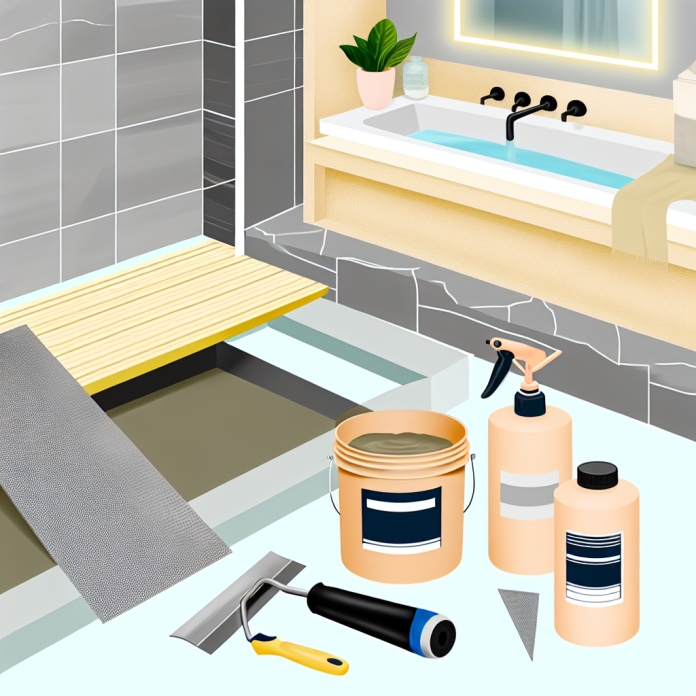If you’ve been wondering how to build a shower curb, you’re in the right place. The installation of a shower curb is essential for keeping your bathroom dry and neatly separated from the shower area. A DIY shower curb is not only a practical addition but also a fulfilling project that even beginners can tackle with the right guidance. Using quality shower curb materials, you can prevent water damage and ensure that your bathroom remains waterproofed. In this guide, we will walk you through the straightforward process of shower curb installation, equipping you with all the necessary tools and tips to succeed.
When it comes to ensuring a water-efficient bathroom, constructing a barrier between the shower area and the rest of the flooring is vital. This barrier, known colloquially as a shower border or threshold, helps control water flow and minimizes dampness. Learning how to create this essential feature involves selecting suitable materials and methods that suit your specific needs. Through our comprehensive guide on building a shower edge, we will explore the key aspects of this home improvement task, including the choice of waterproofing solutions and various installation techniques. Whether you refer to it as a shower curb, shower border, or barrier, the end goal is the same: keeping your bathroom dry and comfortable.
Understanding the Importance of Building a Shower Curb
Building a shower curb is a crucial step in any bathroom renovation project, particularly for those who want to keep their bathroom dry and free from water damage. A shower curb acts as a barrier, separating the shower pan from the rest of the bathroom floor to prevent water from spilling out. Without it, your bathroom can become a damp environment, leading to mold and mildew growth, which can pose health risks and cause costly damage. Understanding this importance is the first crucial step in the DIY shower curb installation process.
Moreover, proper construction of a shower curb significantly enhances the overall functionality and safety of the bathroom. It ensures that water is directed towards the drain, reducing the chances of slipping accidents on wet floors. When planning how to build a shower curb, consider the materials used for flooring and the appropriate waterproofing methods. This knowledge will guide you in choosing the right materials that can withstand moisture exposure, ensuring long-lasting results.
Essential Tools and Materials for Shower Curb Installation
To embark on your DIY shower curb project, it’s essential to gather all necessary tools and materials beforehand. The right equipment not only makes the installation process easier but also ensures a high-quality end result. Key materials include non-corrosive screws, a waterproof pan liner, cement mortar, lath, and Portland cement. Having these supplies ready will minimize interruptions during your project and help maintain your focus on the task at hand.
In addition to the primary items listed, you might also require gloves for safety, a flat trowel knife for smoother application of the mortar, and liner glue to secure the waterproof liner. Understanding how to use these tools effectively is also important. For instance, using a flat trowel knife helps to achieve a smooth surface for the cement mortar, ensuring that the curb is built to last. Taking the time to prepare with the right materials will ultimately lead to a more successful shower curb installation.
Step-by-Step Guide to Building a Shower Curb
Building a shower curb requires a thoughtful approach and adherence to a step-by-step guide. Start by preparing the shower curb area and selecting appropriate materials based on your bathroom floor type. For wooden floors, wood bricks are ideal, while laminate may require a different solution. The height of the curb is also essential; it should facilitate the easy opening and closing of the shower door while containing the water effectively.
Next, ensuring that a waterproof pan liner is installed correctly across the entire bathroom floor is non-negotiable. This layer not only protects against water damage but also enhances the longevity of your shower curb. Following this, carefully cut a drain hole into the liner, allowing for a seamless fit around plumbing fixtures. The finishing touches, including applying cement mortar and a secure fitting of the metal lath, will finalize the curb’s construction, ensuring it is sturdy and waterproof.
Key Considerations for Shower Curb Waterproofing
Waterproofing is perhaps the most pivotal aspect of shower curb installation. A well-constructed curb is only effective if it is properly waterproofed. This includes not merely applying a pan liner but ensuring that all areas are adequately sealed and protected from water entry. Each corner should be covered effectively to avoid leaks, which can lead to significant issues down the line.
In addition, consider using materials specifically designed for waterproofing, such as cement boards, which can provide an extra layer of protection against moisture. The choice of high-quality waterproof pan liner also plays a key role in preventing water from reaching the floor beneath. By prioritizing thorough waterproofing, you can significantly extend the life of your shower curb and maintain a dry, functional bathroom environment.
FAQs About Building a Shower Curb
When it comes to building a shower curb, many common questions arise. One frequently asked question is whether you can build a shower curb out of wood. The answer is yes, especially if you’re working with a wooden floor. However, it’s important to ensure that wood won’t absorb excess water and cause damage. Ensuring the right materials and methods are utilized is critical in achieving a durable and functional barrier.
Another common inquiry pertains to the ideal thickness of a shower curb. Typically, a thickness of 2 to 9 inches is considered ideal, allowing sufficient height to contain water while still maintaining ease of access for shower users. Additionally, many wonder about the necessity of slope in a shower curb. The answer is yes; while a waterproof liner can compensate for some slippage, having a slight slope directs water towards the drain effectively.
The Final Steps in Shower Curb Installation
Once all parts of your shower curb have been assembled according to proper specifications, it is essential to take the time to review your work before proceeding to the installation of wall panels. Allow sufficient drying time for each layer of mortar, as this is crucial for ensuring a solid structure. Remember, a well-dried mortar layer will provide the necessary stiffness and support, which is imperative for the longevity of your shower curb.
In conclusion, by carefully executing these final steps and allowing proper drying times, you increase the success rate of your DIY shower curb installation significantly. Remember, patience during this process can save you time and money in the long run by preventing potential leaks and water damage. Should you need assistance or clarification during any phase of the project, consulting an expert may be beneficial to ensure everything is done correctly.
Safety Precautions During Shower Curb Installation
Safety should be a priority throughout your DIY shower curb installation. Precautions like wearing gloves when handling sharp tools and materials help protect against cuts or injuries. Additionally, working in a well-ventilated area is essential, especially when dealing with cement and adhesives that may emit fumes.
Another critical safety measure is to ensure that your workspace is organized and free from clutter which could lead to tripping or accidents. Using tools correctly and following the manufacturer’s guidelines on all materials will also enhance safety during the installation process. Remember that taking the time to consider safety can prevent accidents and ensure a smoother workflow.
The Benefits of a Well-Constructed Shower Curb
Investing time and resources into building a proper shower curb comes with numerous benefits that extend beyond mere aesthetics. A well-constructed shower curb significantly reduces water spillage, which protects your bathroom flooring and minimizes the long-term risk of mold or mildew growth. This protection not only improves the overall hygiene of the space but can also help maintain property value by preventing water-related damage.
Moreover, an effective shower curb enhances functionality. It provides a defined area for the shower, ensuring that the shower space remains separate from the rest of the bathroom. This separation is not just practical; it can enhance the visual appeal of your bathroom, creating a more cohesive and stylish look. Ultimately, mastering how to build a shower curb correctly leads to a safer, more enjoyable bathroom experience.
Maintenance Tips for Your Shower Curb
Once your shower curb is installed and up and running, it’s crucial to maintain it properly to ensure its longevity. Regular inspections can help catch any signs of wear and tear before they become significant problems. Check the waterproofing layer periodically to ensure it remains intact and that there are no signs of leaking beneath the curb.
In addition to inspections, routine cleaning is essential. Use a non-corrosive cleaning solution to avoid damaging the waterproof liner or the cement mortar. By keeping the area clean and free from debris, you maintain not only the function of your shower curb but also the aesthetic appeal of your bathroom. Regular maintenance will extend the life of your shower curb, ensuring it remains an effective barrier for years to come.
Frequently Asked Questions
How do I build a shower curb for my DIY project?
Building a shower curb for your DIY project involves selecting the right materials, like wood bricks for wooden floors or laminate bricks for laminate floors, ensuring waterproofing with a pan liner, and applying cement mortar with lath for support. Follow detailed instructions for the best results.
What materials do I need to build a shower curb?
To build a shower curb, you will need waterproof pan liner, wood or laminate bricks (depending on your floor type), cement mortar, lath, screws, gloves, and a flat trowel knife. These materials will ensure a durable and waterproof barrier.
What are the steps for shower curb installation?
The steps for shower curb installation include preparing the curb base with the appropriate material, applying a waterproof pan liner, making a drain hole, securing the liner, using metal lath, and finally applying a layer of cement mortar for sturdiness.
How can I ensure my shower curb is waterproof during installation?
To ensure your shower curb is waterproof, use a high-quality waterproof pan liner that covers the entire area, securely attach it around the curb and any corners, and apply cement mortar carefully to seal any gaps.
Do I need to slope my shower curb?
Yes, your shower curb needs to slope correctly towards the drain to prevent water pooling. If you’re using a waterproof liner, it should help redirect water effectively.
Can I build a shower curb on a concrete floor?
Yes, you can build a shower curb on a concrete floor. However, do not use wood as it absorbs water; instead, select materials suitable for concrete, such as masonry blocks and cement mortar.
What thickness should I aim for when building a shower curb?
The ideal thickness for a shower curb is typically between 2 to 9 inches, depending on your design preferences and any local building codes.
Is it safe to build a shower curb without professional help?
Yes, if you correctly follow the installation instructions and ensure you have the necessary tools and materials, you can build a shower curb safely as a DIY project.
| Key Point | Details |
|---|---|
| Importance of Shower Curb | Prevents water from spilling into the bathroom, keeping it dry. |
| DIY Accessibility | Beginner-friendly project that can be done without professional help. |
| Materials Required | Includes waterproof pan liner, cement mortar, lath, and screws. |
| Installation Steps | Prepare curb, apply liner, chop drain hole, cover with lath, and apply mortar. |
| Safety Precautions | Wear gloves, allow drying time, and ensure proper handling of tools. |
| Frequently Asked Questions | Address common concerns about shower curb material, height, slope, etc. |
Summary
To build a shower curb effectively, it’s crucial to follow the outlined steps to ensure proper installation. Beginning with the necessary preparation and right materials, you can create a durable shower curb that keeps your bathroom dry. This DIY project not only saves costs but also gives you a sense of accomplishment in handling home improvements. Remember to implement safety measures throughout the process and consult professionals if needed for any complex aspects.
Source: https://homeyimprovements.com/build-shower-curb/
### Elevate Your Home with OC Remodeling: What You Need to Know
Home renovations in Orange County present an exciting opportunity for homeowners and contractors alike. With a median home value of $1.18 million, the demand for high-quality remodeling services is on the rise, particularly in affluent areas like Laguna Beach and Newport Beach. Homeowners planning renovations valued between $50,000 and $500,000 are seeking professionals who understand local market dynamics, building codes, and permits essential for successful projects.
### Understanding Local Building Codes and Climate Considerations
When embarking on a home remodeling project in California, it’s crucial for contractors to stay updated on state building codes and local regulations specific to Orange County. For instance, Costa Mesa and Huntington Beach might have unique zoning laws that affect structural changes, while the coastal climate necessitates specific materials and designs to resist corrosion and moisture. Knowledge of these factors not only ensures compliance but also enhances the capability of contractors to deliver durable and aesthetically pleasing results.
### Business Opportunities for OC Contractors in High-Demand Remodels
The OC remodeling landscape is competitive, yet affluent homeowners are looking for contractors who can provide innovative designs and responsive service. Opportunities abound in the realms of kitchen and bath remodels, outdoor living spaces, and energy-efficient upgrades. Contractors who demonstrate expertise in utilizing high-end materials and sustainable practices will stand out in the market. Given that many homeowners are focusing on maximizing their property value, contractors should market their services as a means to not just renovate but enhance investment potential. Pursuing referral programs and networking within local business groups can also establish a solid reputation among homeowners.
### Engage with the Local Community and Boost Your Brand
As a contractor in Orange County, engaging with the community can set your business apart. Take part in local home expos or sponsor community events to showcase your services. Additionally, consider leveraging social media platforms to highlight completed projects throughout Irvine and surrounding cities, utilizing SEO strategies focusing on “Orange County remodeling” and “OC contractors” to reach a wider audience. By positioning your brand as an authority in OC home transformations, you’ll naturally attract homeowners eager to elevate their spaces.
In conclusion, the remodeling market in Orange County is ripe with potential for contractors who can navigate the intricacies of local codes and climate while delivering exceptional service. Embrace local engagement strategies, understand homeowner needs, and the opportunities for profitable remodels are limitless.


